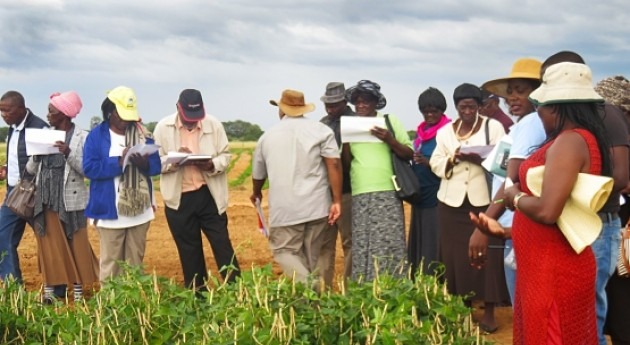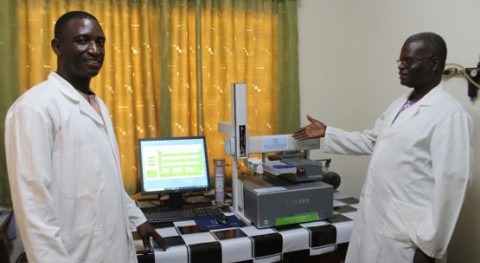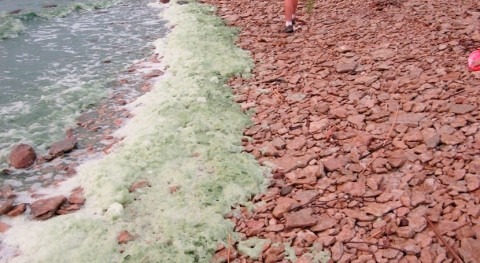Farmers in Namibia now have new crop varieties of cowpea and sorghum that are more tolerant to drought and pests planted this year, thanks to nuclear technology provided with the support of the IAEA and the Food and Agriculture Organization of the United Nations (FAO).
Namibia’s Ministry of Agriculture, Water and Forestry, through an IAEA technical cooperation project which began in 2009, has enhanced existing seed varieties of cowpea and sorghum in its first ever plant breeding programme, released the new varieties in 2018 and facilitated seed multiplication for the 2019 cropping season.
“The achievement in improved crop varieties and quality plays an important role in the production of food and hence ensuring food security,” said Johanna Andowa, Director of Research at the Ministry. “Initially, we only had one sorghum variety and three cowpea varieties, and now with the newly released four sorghum and seven cowpea varieties, farmers have more options to choose from. These varieties are contributing to the national goal of producing high-yielding crops with better tolerance to physical and biological stresses, as well as improved nutritional quality.”
Traditional seed varieties no longer meet the needs of close to 700,000 agricultural households in northern Namibia, where drought and poor soil inhibit crop productivity, Andowa said. “Farmers have reported yield losses and the resulting decrease in productivity is contributing to food insecurity, malnutrition and even famine.”
In response, the IAEA and the FAO have supported Namibia through the transfer of technology and helped to build capabilities in plant breeding and soil and water management.
The new varieties are expected to benefit over 8,000 farmers in the first season, and more farmers will be able to get involved as the seed production increases, Andowa said.
The enhanced cowpea varieties produce higher yields during a shorter growing period, explained Lydia Ndinelao Horn, researcher at the University of Namibia: “They start flowering after 30 days and are fully mature after about two and a half months, while traditional varieties need 60 days just to start flowering.”
Horn highlighted that the new sorghum varieties also have higher yields, as well as increased resistance to the ergot fungus, to which the traditional varieties are susceptible, and which affects yields, also possibly causing serious poisoning if consumed by humans or animals.
To generate the initial batch of seeds, scientists at the Joint FAO-IAEA laboratories in Seibersdorf, Austria, used gamma irradiation on the local seed varieties to induce desired changes in the plants’ DNA. By using radiation to mimic the natural process of spontaneous mutation, scientists can generate varieties with new and useful traits. (see The Science box).
The treated seeds were then shipped back to Namibia, where three crop research stations were involved in the development and examination of new mutant lines for drought and pest tolerance. Farmers then selected best lines during a field trial. As part of this cooperation, the first ever qualified Namibian plant breeder and five plant breeding laboratory technicians were also trained.
In 2018, the improved varieties were given to seed growers for further multiplication, to produce enough seeds for commercial spread. The seeds are currently planted.
Improved soil and water management
Since many of Namibia’s farmers struggle with poor soil fertility, which requires them to use expensive nitrogen fertilizers, experts used a stable isotope of nitrogen to evaluate cowpea varieties for their nitrogen fixing ability. Cowpea is known to add nitrogen to soil, reducing the need for industrial nitrogen fertilizers and therefore boost soil fertility and provide a more sustainable crop yield. The stable isotope of nitrogen (15N) was used to identify cowpea varieties with high ability to fix N and to quantify the amount of N captured by the legume. By initiating crop rotations with cowpea, sorghum yields have increased by approximately 30% and farmers make estimated savings of at least 30% of fertilizers’ costs.
Farmers also need to make sure that the soil is suitable, in order for the plants to reach their full potential. This means that the soil moisture content needs to be just right, so farmers need to know how much to irrigate and when.
Experts installed a ‘drill and drop’ measurement probe, which measures soil moisture, temperature and salinity to monitor water intake of plants. Local experts are now able to analyze the data collected by the probe and notify farmers on their mobile phones of the right time to irrigate. Using this system, farmers are reducing irrigation water use by an estimated 30-40%.
The science
Plant mutation breeding
Plant mutation breeding is the process of exposing plant seeds, cuttings or a shredded plant leaf to radiation, such as gamma rays, and then planting the seed or cultivating the irradiated material. The individual plants are then multiplied and screened for desired traits. Mutation breeding combined with biotechnologies such as molecular marker assisted breeding, often referred to as marker-assisted selection, are used to accelerate the selection of plants with desired traits, carried by genes of interest.
Stable isotope techniques in soil and nutrient management
Nitrogen is a major nutrient for plant growth. By adding nitrogen fertilizers labelled with stable isotope nitrogen-15 (15N) as a tracer to the soil-plant system, scientists can determine the amount of nitrogen derived from the atmosphere by the legume crops, how effectively fertilizer is taken and used by cereal crops and how much is left over.












